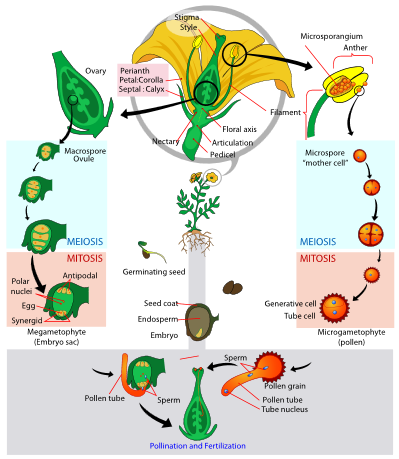This week we continue with last week topic, which is about
the cell division in plant cell, mainly focusing on totipotency. There are four
ways for an explants (for example, a piece of leaves) to form it’s shoots and
roots :
i.
Direct organogenesis – The explants will be
differentiated directly to form its shoots and roots.
ii.
Direct somatic embryogenesis –The explants will
form an embryo, and the embryo will then developed into shoots and roots.
iii.
Indirect organogenesis – The explants will form
callus, a groups of undifferentiated cells and then it will develop to form
organs such as roots or shoots
iv.
Indirect somatic embryogenesis – The explants
will first form callus, the callus then develop into an embryo, and then shoots
and roots will be formed from the embryo.
This are the ways where tissue culture is carry out. In this
topic I learn that it is very important to know the ratio or auxin and
cytokinin in order to let the explants or callus to develop it shoots or roots.
Auxin will be stimulating the growth of shoots, while cytokinin stimulates the
growth of roots. The correct amount is needed to determine the degree of shoot
and/or root formation in tissue culture. A high ratio of cytokinin to auxin
favours shoot production, whereas a high auxin to cytokinin ratio favours root
production. Intermediate levels of both hormones enhance callus formation.
Besides that we should know that when the plants have undergoes tissue culture,
we cannot transfer it immediately to exposure of sun. This is because during
tissue culture, they had adapted to the environment where the humidity is high
and the sun exposure is low. Directly bringing the tissue-cultured plant will
causes the plant to be dehydrated and die. Moreover there are some factors that
need to be considered when we are doing tissue culture, such as the air flow,
fresh media and also sufficient food for the plant. No stress should be given
to the plants, as stress will lead to the increase or hormone ethylene,
excessive of this hormone will cause the retardation of growth. Next there are
also factors need to be considered and decide when totipotency is carry out
such as sources of explants, age of explants, the size of explants, energy
sources, the season where the plant will grow and etc. However there are many
successful cases for tissue culture, there is still a problem to tissue culture
woody plant. Hence woody plant is known as recalcitrous.
Next, we study about reproduction in plant. There are 2 types of
reproduction which are asexual (budding, rhizomes etc. ) and sexual. Sexual
reproduction is the fusion of male and female gametes, where asexual doesn’t
involves the fusion of gametes.
During embryogenesis, the zygote has suspensor which is important for the plant growth. Without it, it will not grow. There is four types of tissue culture, which are embryo culture, organ culture, callus culture and cell culture. If we use anther in culturing this plant we will get a haploid plant.
 |
| Sexual Reproduction |
During embryogenesis, the zygote has suspensor which is important for the plant growth. Without it, it will not grow. There is four types of tissue culture, which are embryo culture, organ culture, callus culture and cell culture. If we use anther in culturing this plant we will get a haploid plant.
| Embryogenesis of dicotyledon plant - where the heart at the heart stage is visible. |
No comments:
Post a Comment